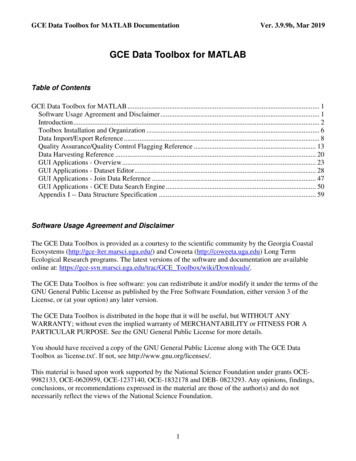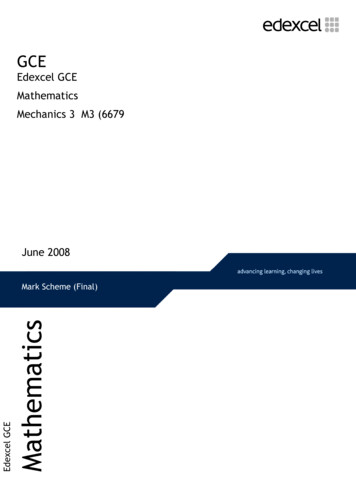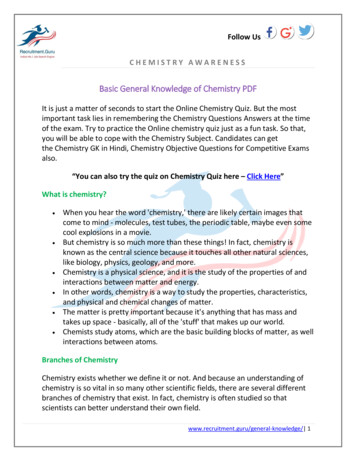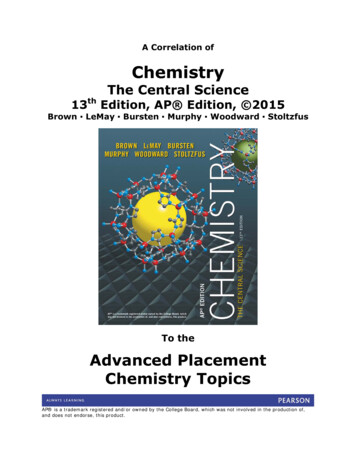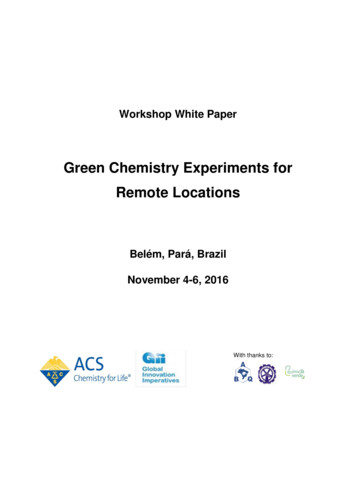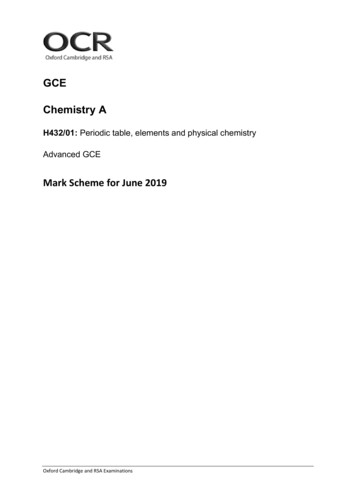
Transcription
GCEChemistry AH432/01: Periodic table, elements and physical chemistryAdvanced GCEMark Scheme for June 2019Oxford Cambridge and RSA Examinations
OCR (Oxford Cambridge and RSA) is a leading UK awarding body, providing a wide rangeof qualifications to meet the needs of candidates of all ages and abilities. OCR qualificationsinclude AS/A Levels, Diplomas, GCSEs, Cambridge Nationals, Cambridge Technicals,Functional Skills, Key Skills, Entry Level qualifications, NVQs and vocational qualifications inareas such as IT, business, languages, teaching/training, administration and secretarialskills.It is also responsible for developing new specifications to meet national requirements andthe needs of students and teachers. OCR is a not-for-profit organisation; any surplus madeis invested back into the establishment to help towards the development of qualifications andsupport, which keep pace with the changing needs of today’s society.This mark scheme is published as an aid to teachers and students, to indicate therequirements of the examination. It shows the basis on which marks were awarded byexaminers. It does not indicate the details of the discussions which took place at anexaminers’ meeting before marking commenced.All examiners are instructed that alternative correct answers and unexpected approaches incandidates’ scripts must be given marks that fairly reflect the relevant knowledge and skillsdemonstrated.Mark schemes should be read in conjunction with the published question papers and thereport on the examination. OCR 2019
H432/01Mark SchemesAnnotations available in RM AssessorAnnotationMeaningCorrect responseIncorrect responseOmission markBenefit of doubt givenContradictionRounding errorError in number of significant figuresError carried forwardLevel 1Level 2Level 3Benefit of doubt not givenNoted but no credit givenIgnoreJune 2019
H432/01Mark SchemesJune 2019Abbreviations, annotations and conventions used in the detailed Mark Scheme (to include abbreviations and subject-specific conventions).AnnotationDO NOT ALLOWMeaningAnswers which are not worthy of creditIGNOREStatements which are irrelevantALLOWAnswers that can be accepted()Words which are not essential to gain creditUnderlined words must be present in answer to score a markECFError carried forwardAWAlternative wordingORAOr reverse argument
H432/01Mark SchemesJune 2019Subject-specific Marking InstructionsINTRODUCTIONYour first task as an Examiner is to become thoroughly familiar with the material on which the examination depends. This material includes: the specification, especially the assessment objectives the question paper the mark scheme.You should ensure that you have copies of these materials.You should ensure also that you are familiar with the administrative procedures related to the marking process. These are set out in the OCRbooklet Instructions for Examiners. If you are examining for the first time, please read carefully Appendix 5 Introduction to Script Marking:Notes for New Examiners.Please ask for help or guidance whenever you need it. Your first point of contact is your Team Leader.3
H432/01Mark SchemesJune 2019SECTION AO2.1Total154Guidance
H432/01Mark SchemesJune 2019SECTION BQuestion16AnswerMarks(a)s-blockAND highest energy or outer electron is in a s orbital or ssub–shell 1(b)FIRST CHECK THE ANSWER ON ANSWER LINEIf answer 25.982 award 2 marks2AOGuidanceelement1.1ALLOW ‘outer’ or ‘valence’ for ‘highestenergy’IGNORE electron configurationsDO NOT ALLOW s shell / energy level2.2 2 ALLOW any correct rearrangement of thissum for first markeg 11.01 x m 2430.5 – 1894.575 – 249.8678.99 23.985 10.00 24.986 11.01 m 24.305 100Relative isotopic mass 25.982 (must be 5 SF) (c)ALLOW ecf for transcription errors in firstsum but answer must be 5 sf(i)CaO H2O Ca(OH)2 12.8(ii)both pH values 7 AND 14ANDpH with SrO pH with CaO 11.2ALLOW multiplesIGNORE state symbolsALLOW CaO 2H2O Ca(OH)2 H2OAND CaO H2O Ca2 2OHALLOW ranges within these values butranges must not overlap
H432/01Mark SchemesQuestion16(d)AnswerJune 2019Marks(i)4.2K(g) O(g) 2K (g) O2–(g) AOelement1.2 4GuidanceMark each marking point independentlyCorrect species AND state symbols requiredfor each markFor e–, ALLOW eFor e– only, IGNORE any state symbolsadded2K (g) O–(g) e– 2K(s) ½O2 (g) 16(ii)FIRST CHECK THE ANSWER ON ANSWER LINEIf answer –2277 (kJ mol-1) award 2 marks262.2 2IF there is an alternative answer, check tosee if there is any ECF credit possible using
H432/01Mark SchemesQuestionAnswerJune 2019MarksAOelementGuidanceworking below–363 – (2 89 249 2 419 – 141 790) See list below for marking of answersfrom common errors–363 – 1914 –2277 (kJ mol–1)ALLOW for 1 mark ONE mistake with signOR use of 2 : 2277 (wrong sign)–601 (2 –419 instead of 2 419)–697 (–790 instead of 790)–1551 ( 363 instead of –363)–1858 (2 419 not used for K)–1921 (2 –89 instead of 2 89)–2152.5 or –2153 ( 249 2)–2188 (2 89 not used for K)–2280 (rounded to 3SF)–2559 ( 141 instead of –141)For other answers, check for a singletranscription error or calculator error whichcould merit 1 mark16(e)(i)2For sodiumatomic radius smaller71.1 2ALLOW ‘Na/sodium is smaller’IGNORE smaller radius / fewer shells / less
H432/01Mark SchemesQuestionAnswerJune 2019MarksAOelementORfewer shells Guidanceshielding if applied to ions butDO NOT ALLOW responses which refer toions losing electronsDO NOT ALLOW moleculesALLOW energy levels for shellsIGNORE fewer orbitals OR fewer sub–shellsALLOW less (electron) shielding OR electronrepulsion between shellsIGNORE just ‘shielding’nuclear attraction increasesOR(outer) electron(s) experience more attraction ALLOW more/stronger/bigger nuclearattraction etcIGNORE ‘pull’ for attractionIGNORE electrons more tightly heldIGNORE ‘nuclear charge’ for ‘nuclearattraction’IGNORE more energy (in question)ALLOW reverse argument for potassiumthroughout16(ii)2Comparison of size of cationsFor sodium ions81.2 2comparison of IONS is essential
H432/01QuestionMark SchemesAnswerJune 2019Marksionic radius of sodium / Na is smaller AOelementGuidanceALLOW Na has a larger charge densityIGNORE ‘Na has smaller atomic radius’ butDO NOT ALLOW contradictory sentences eg‘Na ions have smaller atomic radius’Comparison of attraction of cation and anionNa has stronger attraction to O2- IGNORE pull for attractionALLOW ‘sodium ion’ and ‘oxygen ion’IGNORE just ‘oxygen’ or just ‘O’ for oxygenionALLOW stronger attraction betweenoppositely charged ionsTotal915
H432/01Mark SchemesQuestion17(a)AnswerMarksPlease refer to the marking instructions on page 4 of thismark scheme for guidance on how to mark this question.6Level 3 (5–6 mark)Detailed explanation of equilibrium, the action of the bufferand correct calculation of [HCO3–] : [H2CO3] ratio.There is a well-developed line of reasoning which is clearand logically structured. The information presented isrelevant and substantiated.June 2019AOelement1.1 21.2 23.1 13.2 1GuidanceIndicative scientific points may include:(State symbols not required in equations)Equilibrium and equilibrium shifts H2CO3(aq) H (aq) HCO3–(aq) Addition of H causes to shift to left Addition of OH– causes to shift to rightAction of buffer Increase in H / addition of acid leads to:H (aq) HCO3–(aq) H2CO3(aq)OR HCO3– reacts with added acid Increase in OH– / addition of alkali leads to:H (aq) OH–(aq) H2O(l)ORH2CO3(aq) OH–(aq) HCO3–(aq) H2O(l)ORH2CO3 reacts with added alkaliLevel 2 (3–4 marks)Detailed explanation of equilibrium and the action of the buffer.ORDetailed explanation of equilibrium and correct calculation of–[HCO3 ] : [H2CO3] ratio.ORDetailed explanation of the action of the buffer and correct–calculation of [HCO3 ] : [H2CO3] ratio.ORPartial explanations of equilibrium, and the action of the buffer–and attempt calculation of [HCO3 ] : [H2CO3] ratio.Calculation of [HCO3–] : [H2CO3] ratio Ka 10–6.38 OR 4.17 10–7 (mol dm–3) [H ] 10–7.40 OR 3.98 x 10–8 (mol dm–3)[HCO3–]4.17 x 10–7 OR[H2CO3]3.98 x 10–8 ratio 10.47(:1) OR 10.48(:1)ALLOW 10.5 OR 10(:1) (after working shown)There is a line of reasoning presented with some structure.The information presented is relevant and supported bysome evidence.Level 1 (1–2 marks)Detailed explanation of equilibrium.OR–Correct calculation of [HCO3 ] : [H2CO3] ratio.ORDetailed explanation of the action of the buffer.ORPartial explanations of equilibrium and the action of the buffer.’4.2 x 10–7ALLOW 4.0 x 10–8And ratio 10.5 OR 11 (after working shown)10
H432/01QuestionMark SchemesAnswerMarksJune 2019AOelementORPartial explanation of equilibrium and attempt at calculation of–[HCO3 ] : [H2CO3] ratio.’ORPartial explanation of the action of the buffer and attempt at–calculation of [HCO3 ] : [H2CO3] ratio.Guidance3.98 x 10–[H2CO3]ALLOW [HCO – OR4.17 x 10–73 ]And ratio 1 : 0.095 .There is an attempt at a logical structure with a line ofreasoning. The information is in the most part relevant.0 marksNo response or no response worthy of credit.17(b)3Coordinate bond markO2 (coordinately or datively) bonds with Fe2 /Fe(II)/Fe/Iron 1.1 2Ligand substitution mark(When required) O2 is replaced by H2O OR CO2OR O2 is replaced by COOR H2O OR CO2 is replaced by O2 ALLOW names or symbols of ligandsALLOW H2O/CO/CO2 (coordinately or datively)bonds with Fe2 /Fe(II)/Fe/IronALLOW oxygen donates electron pair to ORbinds with Fe2 /Fe(II)/Fe/IronDO NOT ALLOW Fe3 ALLOW other words for replaced2.1 1Ligand strength markCO forms strong(er) bonds (than O2) Total119ALLOW Kstab for CO (much) higher (than for O2)ALLOW CO bonds irreversibly OR CO is astrong(er) ligandIGNORE affinity
H432/01Mark Schemes(i)[Cr(NH3)6]3 (aq) 1AOelement1.1(ii)CrCl3(aq) 3NaOH(aq) Cr(OH)3(s) 3NaCl(aq)orCr3 (aq) 3OH–(aq) Cr(OH)3(s) state symbols required12.8Question18(a)June 2019AnswerMarksGuidanceIGNORE state symbolsIGNORE square brackets around precipitate formulaeALLOW3 –[Cr(H2O)6] (aq) 3OH (aq) Cr(OH)3(H2O)3(s) 3H2O(l)ALLOW ‘hybrid’ equations,Eg Cr3 (aq) 3NaOH(aq) Cr(OH)3(s) 3Na (aq)[Cr(H2O)6] (aq) 3OH (aq) Cr(OH)3(s) 6H2O(l)3 [Cr(H2O)]6 (aq) 3NaOH(aq) Cr(OH)3(s) 6H2O(l) 3Na (aq)3 (iii)2–Must contain 2 ‘out wedges’, 2 ‘in wedges’ and 2 linesin plane of paper OR 4 lines, 1 ‘out wedge’ and 1 ‘inwedge’:3-D diagram with all bonds through O in OH 1.13– charge 2.3ALLOW dotted line OR unfilled wedge as alternativesfor dotted wedgeIGNORE charges inside brackets18(iv)CrO42– 13.1(v)orange 11.1(b)(i)(1s2)2s22p63s23p63d2 11.1b(ii)Explanation of coloursVO2 goes to V3 (green) AND then V3 goes to V2 33.1 212IGNORE compounds e.g. Na2CrO4ALLOW upper case D, etc. and subscripts, e.g. 3D2If included, ALLOW 4s0
H432/01Mark SchemesQuestionAnswerMarksJune 2019AOelementGuidance(violet) Explanation using Eo values(Eo of) system 4 (VO2 /V3 ) is more positive / lessnegative than system 2 (Fe2 /Fe ) OR(Eo of) system 3 (V3 /V2 ,) is more positive / lessnegative than system 2 (Fe2 /Fe ) 3.2 1Equilibrium shift related to Eo valuesMore positive/less negative system 4(VO2 /V3 ) shifts rightANDMore positive/less negative system 3(V3 /V2 ) shifts right(iii)(c)(i)Fe 4H 2VO2 Fe2 2H2O 2V3 (0.00200 mol dm–3 solution gives) a large titrewhich leads to a small (percentage) error /uncertainty 2.8113.4IGNORE ‘lower/higher’ALLOW reverse argument System 2 more negativethan system 4 etcE ( )0.78 V for system 4 system 2 reactionORE ( )0.18 V for system 3 system 2 reactionFor shifts right’ALLOW (VO2 ) is reduced OR gains electrons(maybe seen as an equation)AND‘For shifts right’ALLOW (V3 ) is reduced OR gains electrons(maybe seen as an equation)IGNORE Fe oxidisedIGNORE state symbolsALLOW multiplesALLOW ‘ ’ALLOW (0.0200 mol dm–3 solution gives) a small titrewhich leads to a large (percentage) error / uncertaintyAssume ‘it’ means dilute solutionALLOW 13.50 cm3 gives a lower percentage errorthan 1.35 cm318c(ii)FIRST CHECK THE ANSWER ON ANSWER LINEIf answer 301 mg award 5 marks52.8 5ALLOW ECF throughoutALLOW working to 3SF minimum throughout13
H432/01Mark SchemesQuestionAnswerMarksJune 2019AOelement13.50n(MnO4–) 1000 0.00200 2.7(0) 10–5 (mol) GuidanceCommon errors602 (mg) (not dividing by 2) 4 marks37.7 (using 55.8 instead of 445.8) 4 marksn(Fe2 ) (in.25.0 cm3) 2.7(0) 10-5 5 1.35 10–4 (mol) n(Fe2 ) (in 250 cm3) 1.35 10-4 10 1.35 10–3 Mass C12H22FeO14 in 2 tablets 1.35 10–3 445.8 0.6018 (g) Mass C12H22FeO14 in 1 tablet 301 (mg)AND to 3 SF (iii)A: Mass Fe 180 x 55.8 66 mg151.8B: Mass Fe 210 x 55.8169.8 69 mgLast mark involves dividing by two and converting g tomg. These steps may be seen earlier1Iron supplement:B provides more Fe per tablet 3.1 1ALLOW correct working if iron supplement is notnamedALLOW iron(II) fumarate or C4H2FeO41814
H432/01Mark SchemesQuestion19(a)AnswerMarks(i)More energy is released by forming bondsthan energy required when breaking bondsORbond enthalpy of bonds being made is higher thanbond enthalpy of bonds being broken 1(ii)FIRST CHECK ΔGIf ΔG –1010 (kJ mol–1) award first 3 marks4June 2019AOGuidanceelement1.2Response needs link between energy, breaking andmaking bondsEg ‘bond breaking is endothermic’ AND ‘bondmaking is exothermic’ AND ‘exothermic changeoutweighs endothermic change’IGNORE more bonds made than broken2.2 3ALLOW ecf S (2 248 2 70) – (2 206 3 205) –391 (J K–1 mol–1 ) OR –0.391 (kJ K–1 mol–1) ΔG ΔH – TΔS –1125 – (293 –0.391) ALLOW –1010000 (J mol–1)ALLOW 3 SF up to calculator value –1010.437 –1010 (kJ mol–1) Common errorsALLOW:Two calculation marks for:–1117 to 3 SF up to calculator value of–1117.179865(use of 20 instead of 293)( )113438 (kJ mol–1) or 113000, 113400, 113440(mix of J and kJ)–1008 up to calculator value of –1008.482(use of T 298)–1018 up to calculator value of –1018.257(use of T 273)3.2 1Feasible AND G 0 OR G is negative 19a(iii) FIRST CHECK THE ANSWER ON ANSWER LINEIf answer –20 (kJ mol–1) award 3 marks3152.2 3ALLOW ECF for from incorrect G,eg Non feasible AND G 0 OR G is ve
H432/01Mark SchemesQuestionAnswerMarksJune 2019AOelementGuidanceFirst mark may be awarded from data on a cycleUsing Both cH values multiplied by 22 (–296.8) or –593.6AND2 (–285.8) or –571.6 ( –1165.2) oALLOW – 20.1(0)Use of –1125 and correctly processed:2 fH(H2S) [2 (–296.8) 2 (–285.8)] – (–1125) –40.2 (kJ mol–1) ALLOW ECF: third mark is for dividing by 2and use of all three valuesDivision by 2 fH(H2S) –20 (kJ mol–1) Common errorsTwo marks for ( )20(.1)ALLOW ecf if no multiplication by two occurred[(–296.8) (–285.8)]–(–)1125 ( )542.4 for 2nd markLeading to fH(H2S) ( ) 271(.2) for 3rd markALLOW –296.8 –285.8 – 582.6 for 1st mark if1125/2 OR – 562.5 is seen in 2nd mark(b)(i)(Kp) p(SO3)2(g) p(SO2(g))2 p(O2(g))2atm–1 1.2 2ALLOW species without state symbols and withoutbrackets.e.g., pSO32, ppSO32, PSO32, p(SO3)2 (pSO3)2etc.DO NOT ALLOW square bracketsALLOW atm as ECF if Kp is upside downALLOW use of any pressure uniteg Pa–1 or kPa–116–
H432/01Mark SchemesQuestion19b(ii)June 2019AnswerMarksFIRST CHECK THE ANSWER ON ANSWER LINEif answer 27.2 award 5 ---------------------------Initial amounts10.2n(SO2) (24.0 ) 0.425 (mol) AND12n(O2) (32.0 ) 0.375 (mol) Equilibrium amounts in molesn(SO2) (0.425 – 0.350 ) 0.075 (mol) ANDn(O2) (0.375 – 0.350/2 ) 0.200 (mol) 5Total molesntot 0.625 (mol) Partial pressures0.075pSO2 (0.625 2.50 ) 0.3 (atm) AND0.2pO2 ( 2.50 ) 0.8 (atm) AND0.6250.350pSO3 ( 2.50 ) 1.4 (atm) 0.625AOGuidanceelement2.6 5 IF there is an alternative answer, check to see ifthere is any ECF credit possible using workingbelow.Common errorsAllow 4 marks for 1.45/1.46 (depending uponrounding)Initial amountsn(SO2) 2 x n(O2)n(O2) 0.375 and n(SO2) 0.75(0)Equilibrium molesn(SO2) 0.75 – 0.350 0.4(0)n(O2) 0.2(0)total molesntot 0.95partial pressurespSO2 1.05pO2 0.526pSO3 0.921Allow 4 marks for 15.1/15.0Initial amountsn(O2) 12/16 0.75Equilibrium molesn(O2) 0.575total molesntot 1.00partial pressurespSO2 0.188pO2 1.438pSO3 0.88Kp to 3 SF1.42(Kp ) 27.2 (atm–1) 0.32 0.8IGNORE units17
H432/01Question19bMark SchemesAnswerJune 2019Marks(iii) (greater Kp value means) equilibrium position shifted toright/RHS Lower temperature because (forward) reaction isexothermic (iv) equilibrium position (far) to the right 21AOGuidanceelement3.2 2 ALLOW greater/higher amount of SO3/productALLOW greater Kp means larger numerator3.2ALLOW (very) high yield of products or of SO3ALLOW reaction is nearly complete / irreversibleALLOW Forward reaction is (greatly) favoredALLOW (far) more product(s) than reactant(s) orALLOW equilibrium (greatly) favours product18
H432/01Mark SchemesQuestion19(c)AnswerJune 2019Marks(i)4AOelement1.1 4DO NOT ALLOW two curvesConfusion with effect of temperatureCorrect drawing of Boltzmann distributionCurve starts within one small square of originAND not touching the x axis at high energy DO NOT ALLOW ‘enthalpy’ for x-axis labelDO NOT ALLOW ‘atoms’ as y-axis labelAxes labels:y: (number of) molecules/particlesAND x: (kinetic) energy ALLOW ECF for atoms (instead ofmolecules/particles) if y axis labelled as ‘atoms’Catalyst and activation energyCatalyst provides a lower activation energy OR Ecshown to the left of Ea on Boltzmann distribution Particles with E Eamore or a greater proportion of molecules / particles /collisions have (energy above) activation energy (withcatalyst) OR more molecules have enough energy toreact OR greater area under curve above activationenergy (ii)Guidanceheterogeneous (catalyst) ANDcatalyst in a different phase/state (from othersubstances) IGNORE (more) successful collisionsIGNORE response implying ‘more collisions’(confusion with effect of greater temperature)1Total19231.2ALLOW catalyst is a solid AND not a gas /everything else is a gas
H432/01Mark SchemesQuestion20(a)AnswerMarksFIRST CHECK THE ANSWER ON ANSWER LINEIf answer 2.98 award 2 ----------------------------[H ] (Ka [C2H5COOH]) 1.039 10–3 (mol dm–3) 2June 2019AOelement2.2 2(i)n(C2H5COOH) (0.0800 Common errors (Must be to 2 DP)One mark for pH 5.97 (No square root):125.0) ) 0.002 (mol)10000.002V(NaOH) 0.100 1000 ( 20(.0) cm3 ) b(ii)2.5One mark for pH 0.92 OR pH 5.15 (Usingincorrect Ka values)ALLOW 0.02 dm3 if unit givenMark is for WORKING which could all be shown as1 stepAND20ALLOW ECF throughoutONLY ALLOW pH mark by ECF if Ka AND 0.080used and AND pH 7pH –log 1.039 10–3 2.98 (Must be to 2 DP) (b)GuidanceALLOW method showing 20cm3 NaOH containsthe same moles as acidn(C2H5COOH) 0.08(00) x 0.025(0) 0.002 (mol)andn(NaOH) 0.02(00) x 0.1 0.002(00) (mol)FIRST CHECK THE ANSWER ON ANSWER LINE420ALLOW ECF throughout
H432/01Mark SchemesQuestionAnswerMarksJune 2019AOelementIf answer 12.55 award 4 -----------------------------GuidanceFor first mark ALLOW(Excess volume of NaOH 25(.0) cm3)25.0n(OH–)excess 0.100 1000 0.0025 (mol)Excess mol of NaOH:n(OH–)excess n(OH–) – n(C2H5COOH)45.025.0 (0.100 )–(0.0800 10001000)1.2 1 0.0045 – 0.002 0.0025 (mol) 2.6 3Concentration of OH–:0.0025[OH–] () 0.0357 (mol dm–3) 70.0 10–3Common errorsIf initial V(NaOH) 45 cm3[OH–] 0.0643 (mol)[H ] 1.56 10–13 (mol dm–3)pH 12.81 award three marks (no 1st mark)If n(OH–)excess is used in [H ] calculationn(OH–)excess 0.0025 (mol)1.00 10–14–12–3[H ] 0.0025 4.(00) 10 (mol dm )pH 11.40 award three marks (no 2nd mark)Concentration of H :1.00 10–14–13–3[H ] (0.0357 ) 2.8 10 (mol dm ) ALLOW pOH method for last two markspOH – log[OH–] 1.447Conversion to pH:pH (–log 2.8 10–13) 12.55 pH 14 – 1.447 12.55ALLOW ECF for conversion from [H ] to pHprovided value calculated is above 7 and fromderived [H ]20b(iii) Shape3212.3 1If pH curves wrong way round (i.e. adding acid to
H432/01Mark SchemesQuestionAnswerMarksJune 2019AOelementSlight rise/flat, AND (near) vertical, AND then slight rise/flat Guidancealkali),ONLY award mark for End point ( 20 cm3)2.4 2pHVertical section within the extremes of pH 5 to 12 and aminimum range of three pH unitsAND middle of vertical section (equivalence point) needs tobe above pH 7 End pointVertical section at 20 cm3 NaOH (iv) cresol purple(v)ANDpH range matches vertical section/rapid pH changeORend point/colour change matches vertical section/rapid pHchange similarity: end point / volume (20 cm3) of NaOH needed toneutraliseORfinal pH / shape of curve after end point difference: HCN higher starting pHORHCN shorter vertical section 13.323.2 2ALLOW pH range (of the indicator) matchesequivalence pointALLOW end point/colour change matchesequivalence pointIGNORE colour change matches end pointColour change is the same as end pointEnd point must not refer to same pHALLOW different equivalence pointIGNORE different starting pH22
H432/01Question20(c)Mark SchemesAnswerMarks1HIO3 dissociation is not negligible / dissociates to asignificant extentORLarge Ka and HIO3 is ‘stronger’ (weak) acidOR[HIO3 ]eqm is significantly lower than [HIO3 ]initial/undissociated June 2019AOelement3.3GuidanceALLOW use of HAIgnore [HIO3]equilibrium [HIO3 ]initial/undissociatedALLOW[HIO3]equilibrium [HIO3]undissociated is no longer a validassumptionALLOW[HIO3] has a larger Ka so the assumption that[HIO3] at equilibrium [HIO3] initially soassumption is not validTotal2315
H432/01Question21Mark SchemesAnswerMarksPlease refer to the marking instructions on page 4 of thismark scheme for guidance on how to mark this question.6Level 3 (5–6 marks)Most evidence used to determine the correct ordersAND rate equation AND rate constant.There is a well-developed line of reasoning which is clearand logically structured. The information presented isrelevant and substantiated.June 2019AOelement3.1 43.2 2GuidanceIndicative scientific points may include:OrdersStudent 1 zero order wrt Br2Student 2 1st order wrt CH3COCH3Student 3 1st order wrt H ExplanationsStudent 1 constant gradient OR linear negative gradientOR constant rate OR rate independent ofconcentration OR decreasing half-lifeStudent 2 straight line through 0,0 OR rate directly proportional to [CH3COCH3]OR [CH3COCH3] 2, rate 2Student 3 [H ] 2, rate 2Level 2 (3–4 marks)Some evidence used to determine two orders correctly ANDrate equation AND rate constant consistent with orders.ORLittle evidence used to determine all three orders correctlyAND rate equation AND rate constant.There is a line of reasoning presented with some structure.The information presented is in the most part relevant andsupported by some evidence.Level 1 (1–2 marks)Little evidence used to determine two orders correctlyOROne order correct, with attempt to determine the rateequation AND rate constant.Rate equation, rate constant and units rate k [CH3COCH3] [H ]ALLOW rate k [Br2]0 [CH3COCH3]1 [H ]1rate1.25 10–5 k OR[ CH3COCH3] [H ]1.6 0.2–5 k 3.9 10 units: dm3 mol–1 s–1 (Any order, e.g.mol–1 dm3 s–1)There is an attempt at a logical structure with a line ofreasoning. The information is in the most part relevant.0 marksNo response or no response worthy of credit.Total246
OCR (Oxford Cambridge and RSA Examinations)The Triangle BuildingShaftesbury RoadCambridgeCB2 8EAOCR Customer Contact CentreEducation and LearningTelephone: 01223 553998Facsimile: 01223 552627Email: general.qualifications@ocr.org.ukwww.ocr.org.ukFor staff training purposes and as part of our quality assuranceprogramme your call may be recorded or monitoredOxford Cambridge and RSA Examinationsis a Company Limited by GuaranteeRegistered in EnglandRegistered Office; The Triangle Building, Shaftesbury Road, Cambridge, CB2 8EARegistered Company Number: 3484466OCR is an exempt CharityOCR (Oxford Cambridge and RSA Examinations)Head officeTelephone: 01223 552552Facsimile: 01223 552553 OCR 2019
Chemistry A . H432/01: Periodic table, elements and physical chemistry . Advanced GCE . Mark Scheme for June 2019. OCR (Oxford Cambridge and RSA) is a leading UK awarding body, providing a wide range of qualifications to meet the needs of

